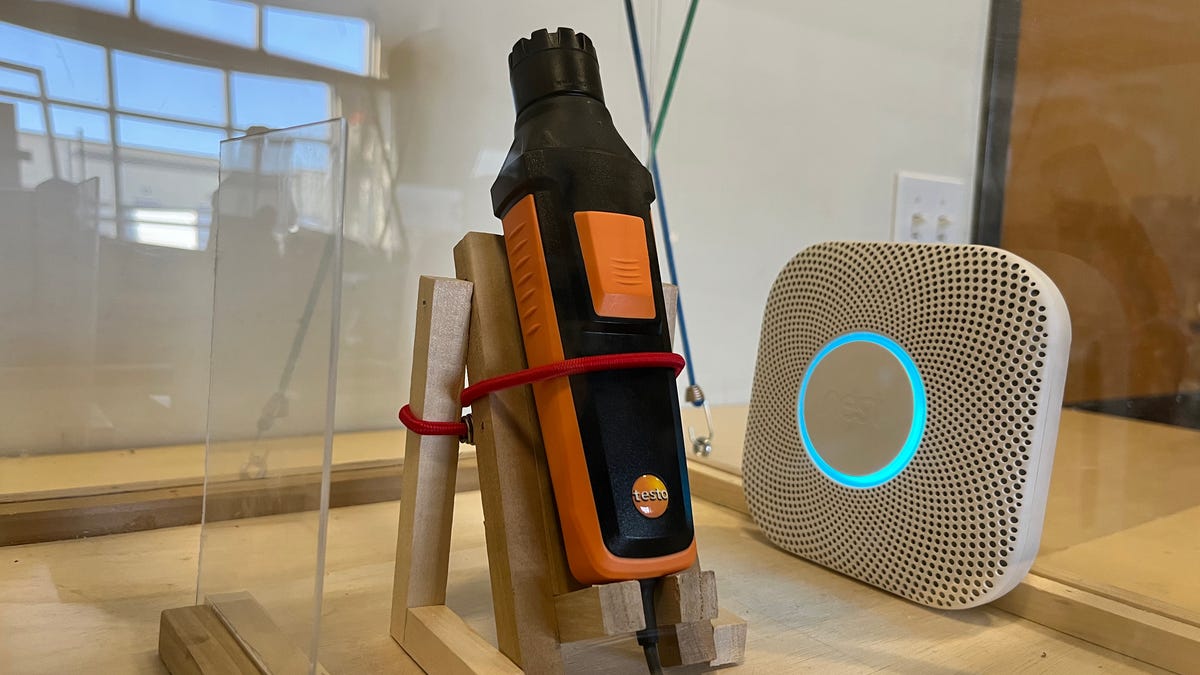Carbon monoxide, or CO, is a colorless, odorless gas that can be extremely dangerous to human health. It is produced by the incomplete combustion of fuels such as gasoline, oil, wood, propane and natural gas, and it can build up in enclosed spaces such as homes, garages and basements without you knowing it.
The way it works is a threat because it displaces oxygen. When humans breathe in carbon monoxide, it binds to the hemoglobin in their red blood cells, replacing and reducing the amount of oxygen that can be carried by the blood. This leads to a range of symptoms, from headaches and dizziness to confusion, nausea and even death.
Having a Carbon Monoxide detector in your home is highly recommended. Itcan alert you to the presence of dangerous levels of CO and give you time to evacuate and seek medical attention if necessary. This is especially important because CO is often referred to as the “silent killer” due to its lack of odor or taste. To help you make the right decision, we gathered seven of the most popular carbon monoxide detectors and evaluated their ability to detect carbon monoxide at two hazardous concentration levels, 250 and 400 ppm (parts per million). Here are our picks.
At an average retail price right around $35, the CO615 from First Alert is the perfect carbon monoxide alarm if you’re looking for handy features and decent performance at an affordable price.
If all you need is a carbon monoxide alarm that can reliably watch your back without leaving a hole in your pocket, then the First Alert CO400 is perfect for the task. Basic features include a single test/silence button and a very loud alarm. It doesn’t come with a digital display or any smart features, but it makes up what it lacks in fancy looks with performance and affordability. Typically available for $25 or less, the CO400 was the least expensive CO detector we tested, and it was also the fastest at detecting carbon monoxide at both concentration levels. At 250 ppm, its alarm was set off after an average of 10 minutes, 46 seconds and at 400 ppm, it only took 7 minutes, 3 seconds. Those are excellent results, regardless of price.
Some units have the ability to detect both carbon monoxide molecules and smoke particles. These are called “combo” or “two in one” units. The First Alert Onelink 1042136 stood out in this category. This device got second place in our quickness of response test, detecting CO at 250 ppm after only 11 minutes, 42 seconds and, similarly, CO at 400 ppm after 8 minutes, 10 seconds.
How we test carbon monoxide detectors
To put these detectors to the test, we took to the lab and built a test rig designed to measure each unit’s response time to varying concentrations of carbon monoxide, specifically at 250 ppm and 400 ppm. Our goal was to determine each detector’s respective effectiveness at detecting potentially hazardous levels of carbon monoxide. To declare our winners, we also took into account features that add to the overall user experience, performance and cost-efficiency of each unit.
For the 250 ppm concentration level, we try to simulate a situation where carbon monoxide has begun to build up to hazardous levels. We test twice at this concentration and average the results. At 400 ppm, we replicate a worst-case scenario, a potentially deadly situation, and give the units a pass or fail score. Spoiler alert: They will all save your life, which goes to show how important it is to have a carbon monoxide detector installed in every floor of your home.
Our custom-built carbon monoxide detector test station. It’s one of the deadliest things we’ve ever put together in our product testing lab.
This is one of the most dangerous tests we’ve ever conducted. Carbon monoxide exposure is no joke. It’s virtually undetectable and, well, quite deadly. We needed to create a safe way of testing carbon monoxide detectors without risking the health and safety of our laboratory staff. So, I made use of my rudimentary carpentry skills and built a CO detector test station. Its components are:
- CO detector chamber — made using wood, plexiglass, silicon, tape and a bunch of finish nails.
- CO tank with gas flow regulator — cylinder tank containing CO at 2,500 ppm and balance air.
- Testo 300 with CO Ambient sensor — our control device for this experiment.
- Two portable CO gas alarms.
On the left, our CO Ambient sensor attachment for the Testo 300. On the right, our UUT, or “unit under test” — in this case, the Nest Protect Smoke and CO Alarm
The chamber houses two carbon monoxide detecting devices, a) the CO Ambient sensor portion of our control device, the Testo 300, which is a combustion analyzer used by heating engineers who carry out installation and routine maintenance of industrial and residential heating systems, and b) the unit under test, or UUT, which takes the place of each carbon monoxide detector we tested for you. The chamber is sealed with foam but not air-tight, since we’re not particularly interested in making a CO bomb.
We use a portable CO alarm on the gas regulator to keep a nose out for leaks.
We installed a gas flow regulator on our tank to avoid pressure spikes, followed by a gas line to feed our gas mixture into the chamber. Two additional portable CO detectors are used. One near the valve, to ensure there are no leaks, and another that must be worn by the person carrying out the experiment to make sure there is no CO buildup in the test station area. On top of all that, our respirator suits and amply ventilated location ensure that we get a constant stream of fresh air at all times. This might all sound excessive, but it’s always good laboratory practice to put safety first, especially when you’re dealing with such a stealthy and prolific killer.
We start by feeding our gas mixture to the chamber, closely monitoring the carbon monoxide concentration on the Testo. Once the concentration inside our chamber reaches at least 250 ppm or 400 ppm, we stop feeding the gas and start a timer. We want to assess how long the carbon monoxide detectors take to react to those conditions. As you may understand, we wanted to limit our exposure while making sure our results were repeatable.
Our results are summarized in the interactive graph below:
Other carbon monoxide detectors we’ve tested
Nest Protect smoke and carbon monoxide alarm: A very compelling option for those who don’t mind spending a little more in exchange for a wide range of smart features including location specific voice alarm, color-coded emergency notifications and smartphone app control for silencing and routine testing. However, it underperformed its competition in our quickness of response test, with a bottom-three result in the 250 ppm run and last place in the 400 ppm run. Fortunately, it did a better job at quickly detecting smoke and fire hazards during our most recent round of smoke detector tests.
Kidde KN-COPP-B-LPM battery-operated carbon monoxide alarm: Battery powered, digital display, test/reset and peak CO buttons, visual cues for alarm and operational status. Great unit if you want an affordable device that is capable of monitoring real-time CO levels as well as battery life. Not the fastest at detecting carbon monoxide (it ranked fourth). CO readouts on its screen are the least accurate of the bunch, at 15% error, which is by no means the end of the world.
X-Sense combination smoke and carbon monoxide alarm: This combo unit comes equipped with a 10-year sealed lithium battery and a digital display that shows real-time CO concentration, battery level and working status. Second to last place in our quickness of response test, detecting CO at 250 ppm after 20 minutes. CO concentration monitor is accurate, less than 5% error. However, its LCD display is smaller than those of other products in this category, which makes it a little hard to interpret the readouts if you’re not close to the device.
Kidde Plug-in KN-COB-DP2 carbon monoxide alarm: A plug-in unit, backed up by two AA batteries. Features a single LED indicator and a test/reset button. Very specific brand and model requirements for battery replacements. The unit does not come with a cord extension so its installation placement is limited to an electrical outlet. Last place in our quickness of response test.
Carbon monoxide detector FAQs
How do carbon monoxide detectors work?
Carbon monoxide detectors work by using sensors to detect the presence of CO in the air. When CO levels reach a certain threshold, the detector sounds an alarm to alert occupants of the building. There are different types of detectors available, but most use electrochemical sensors, metal oxide semiconductors or biomimetic sensors to detect CO.
Where should carbon monoxide detectors be placed?
Carbon monoxide detectors should be placed on every level of the home and in every sleeping area. They should also be placed near sources of potential CO, such as furnaces, water heaters, fireplaces and attached garages. Follow the manufacturer’s instructions for the specific placement of your detector.
How often should carbon monoxide detectors be replaced?
Carbon monoxide detectors should be replaced every five to seven years, depending on the manufacturer’s recommendations. Regular testing and maintenance are also important to ensure that the detector is functioning properly and providing adequate protection.
What should I do if my carbon monoxide detector goes off?
Never ignore a carbon monoxide alarm. If your carbon monoxide detector goes off, evacuate the building immediately and seek fresh air. Call the fire department or emergency services from a safe location and do not re-enter the building until it has been checked and declared safe.




